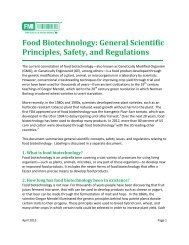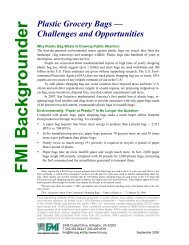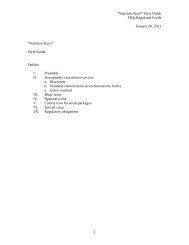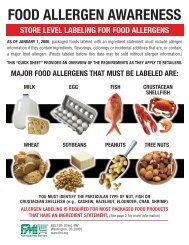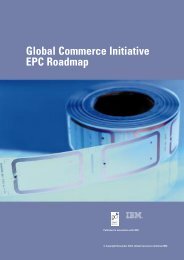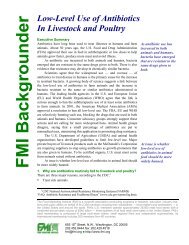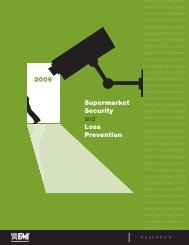Shelf Price Accuracy in Supermarkets That Scan - Food Marketing ...
Shelf Price Accuracy in Supermarkets That Scan - Food Marketing ...
Shelf Price Accuracy in Supermarkets That Scan - Food Marketing ...
Create successful ePaper yourself
Turn your PDF publications into a flip-book with our unique Google optimized e-Paper software.
<strong>Shelf</strong> <strong>Price</strong> <strong>Accuracy</strong> <strong>in</strong> <strong>Supermarkets</strong> <strong>That</strong> <strong>Scan</strong><br />
In stores that lack scanners, discrepancies occur when checkers <strong>in</strong>advertently<br />
r<strong>in</strong>g up the wrong prices or when employees fail to make price<br />
changes <strong>in</strong> a uniform manner. Discrepancy rates are higher <strong>in</strong> stores that<br />
mark items <strong>in</strong>dividually because this practice <strong>in</strong>creases the opportunities<br />
for human error.<br />
The <strong>in</strong>dustry is improv<strong>in</strong>g accuracy with technologies that change<br />
prices on shelf tags and scanners at the same time. In another solution, employees<br />
use portable computers to pr<strong>in</strong>t out new shelf labels <strong>in</strong> the aisles.<br />
Many supermarkets are upgrad<strong>in</strong>g management controls, such as conduct<strong>in</strong>g<br />
frequent shelf price accuracy audits and assign<strong>in</strong>g employees to monitor<br />
price changes full-time.<br />
Us<strong>in</strong>g the measures described above, supermarkets have reduced error<br />
rates, accord<strong>in</strong>g to research by the Federal Trade Commission (FTC).<br />
In the days before scann<strong>in</strong>g, error rates were as high as 16 percent. With<br />
the help of scann<strong>in</strong>g and tighter controls, supermarkets reduced the rate to<br />
2.42 percent <strong>in</strong> 1998, the most recent year for which FTC data is available<br />
(<strong>Price</strong> Check II ⎯ A Follow-up Report on the <strong>Accuracy</strong> of Checkout<br />
<strong>Scan</strong>ners). <strong>That</strong> rate <strong>in</strong>cludes both overcharges and undercharges, which<br />
were nearly the same at 1.36 percent and 1.06 percent, respectively.<br />
<strong>Supermarkets</strong> also have the highest price accuracy rate among all<br />
types of retailers. The error rate for other retailers covered <strong>in</strong> the FTC report<br />
was 3.99 percent.<br />
In addition, weights and measures officials have stepped up enforcement<br />
of laws that penalize retailers for overcharges. Also, their govern<strong>in</strong>g<br />
body, the National Conference on Weights and Measures (NCWM), developed<br />
a methodology to measure price consistency more accurately and<br />
better gauge the success of efforts to improve it. The methodology is described<br />
<strong>in</strong> the guide titled Exam<strong>in</strong>ation Procedure for <strong>Price</strong> Verification.<br />
1. What are scanner pric<strong>in</strong>g errors and how do they occur<br />
The most common ones are discrepancies between the prices charged<br />
at the register and those posted on the shelf, result<strong>in</strong>g <strong>in</strong> either an undercharge<br />
or overcharge for the customer. Such <strong>in</strong>consistencies are a product<br />
of human error: <strong>in</strong> most cases, store employees enter a price change <strong>in</strong> the<br />
scann<strong>in</strong>g system without updat<strong>in</strong>g the shelf tag.<br />
2. Is the supermarket <strong>in</strong>dustry concerned about this issue<br />
Absolutely. Overcharges erode customer loyalty, and undercharges<br />
cost the <strong>in</strong>dustry. <strong>Supermarkets</strong> are striv<strong>in</strong>g to achieve 100 percent pric<strong>in</strong>g<br />
accuracy. Many have virtually elim<strong>in</strong>ated overcharges with a relatively<br />
simple price-change practice: When the price of an item <strong>in</strong>creases, they<br />
change the shelf label first and then the scanned price at the checkout;<br />
when the price decreases, they change it <strong>in</strong> the scanner first. This practice<br />
helps ensure that any errors will favor the customer.<br />
3. How much do pric<strong>in</strong>g errors cost customers<br />
The most reliable data show that the cost to consumers is m<strong>in</strong>imal.<br />
The 1998 FTC report found that the error rate among food retailers averaged<br />
2.42 percent with overcharges and undercharges about equal, 1.35<br />
The <strong>in</strong>dustry is<br />
improv<strong>in</strong>g accuracy with<br />
technologies that<br />
change prices on shelf<br />
tags and scanners at the<br />
same time.<br />
The most reliable<br />
data show that the<br />
cost to consumers is<br />
m<strong>in</strong>imal.<br />
<strong>Food</strong> Market<strong>in</strong>g Institute 2




